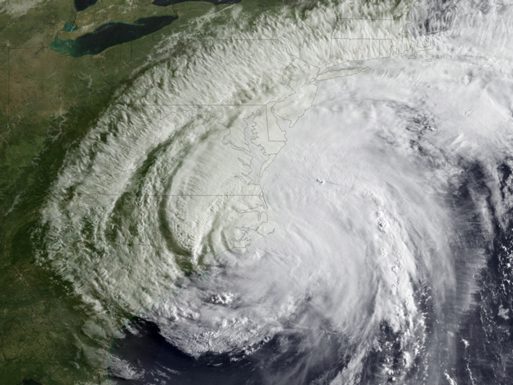Stormy Septembers in the Piedmont

The Atlantic hurricane season spans half the year, June through November, but North Carolina typically sees the most storms, and some of the worst, in September. Our coast is especially vulnerable to hurricanes, but we sometimes experience their devastation here in the Piedmont.
In the fall of 1989, I was living in Chapel Hill in a rickety clapboard house surrounded by towering pines. When I went to bed on Sept. 21, the Triangle was bracing for Hurricane Hugo. Mama had tried to convince me to make some preparations – she remembered Hurricane Hazel passing through Chatham County in October 1954 – but I was naively nonchalant. We had a rainy, windy night, but when I looked out the next morning, I thought, “That wasn’t so bad.” Then I learned the storm had missed us, coming ashore near Sullivan’s Island, S.C., killing 27 people in South Carolina and heading straight toward Charlotte.
I heard the Hugo stories when we moved to Charlotte several years later, to a neighborhood that had been devastated by its beloved willow oaks. People couldn’t even leave the neighborhood because trees had clogged the streets. Some people didn’t have electricity for nearly two weeks. Throughout the ordeal, they fired up grills and shared the food in their freezers, creating a moveable feast of hospitality and cheer in the face of adversity.
So when Fran approached the state on Sept. 5, 1996, on a path eerily similar to Hugo’s, I took it seriously. I filled pitchers and jugs and bathtubs with water. I maxed out my ATM withdrawal. I gassed up the car and considered parking it near the freeway in case we needed to escape to the Uwharries. And I waited. All night. Fran made landfall farther north than predicted and followed the Cape Fear River toward the Triangle.
I managed to dodge both storms, but the Uwharries weren’t so lucky. In Montgomery County, Hugo damaged 75 houses, 100 outbuildings and hundreds of acres of crops – an estimated 75 percent of soybeans, 60 percent of corn and 10 percent of tobacco. Some 5,000 customers lost power, but electricity was fully restored within three days. With an estimated $1.25 million in losses, the county was declared a disaster area.
Fran made landfall near Bald Head Island, and within hours much of Montgomery County was without power. Before daybreak, Troy Lumber Co. went up in flames. As temperatures rose throughout the day, poultry farmers began to lose their flocks. By evening, the town of Troy was without water. There were problems locating a generator large enough for the pumping station at Old Dairy Road. Five days after the storm, 1,000 residents were still without power. Fran went on to cause as many as 26 deaths in North Carolina and left an estimated $5 billion in damage in the state.
In the Uwharries, hurricanes can have immediate and long-term impacts on our forests. Initially, there’s a loss of board-feet in our timberlands. Hugo damaged 2.7 million acres of forest in North Carolina, most of it in the Piedmont. Timber losses exceeded $250 million. State totals for Fran were much higher, primarily because it made landfall along the N.C. coast – 8.2 million acres of forest damaged with losses approaching $1.3 billion. Even though the eastern part of the state was hit harder than the Piedmont, almost 200,000 acres were damaged in Montgomery County alone, at a cost of nearly $21 million.
In a hurricane, trees are toppled, especially once the ground is saturated, and many have their tops broken out. Even less drastic damage can make trees susceptible to the southern pine beetle and other pests. Downed timber increases both the risk and intensity of wildfires for many years. To make matters worse, firefighters have trouble getting to a blaze if downed trees and limbs block roads in the forest.
September hurricanes can also affect the peak of our outdoor recreation season. Hikers and bikers find sections of their favorite trails impassible. Hunters have to repair or replace their deer stands, and clear debris if they want to get to them with trucks or ATVs. If mast-producing trees come down, the species composition on their land will change. Early successional habitat will be more attractive to rabbits than deer.
For those of us who appreciate the beauty of our forests and the shade trees in our yards, the loss of even a single tree can be painful. We know a mature tree won’t be replaced in our lifetime. We have to remind ourselves that hurricanes, like fire, are a force of nature. Our forests are dynamic, always evolving.
Irene spared the Uwharries, although it caused extensive flooding in the Northeastern states. Katia drifted back into the Atlantic, and its remnants pounded Britain on Monday. Storms are still developing off the coast of Africa and moving into the Caribbean, and over the coming weeks, we’ll see what they have in store for the Piedmont.
– Ruth Ann Grissom
Special thanks to Rob Trickel of the N.C. Division of Forest Resources for information on damage to our forests and to The Montgomery Herald for its coverage of Hugo and Fran. For more information about hurricanes in our state, see North Carolina’s Hurricane History by Jay Barnes.